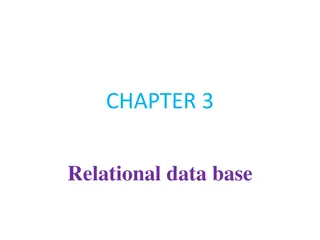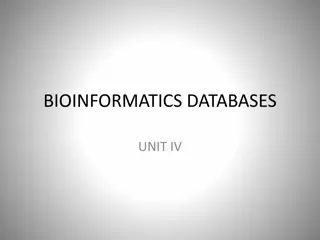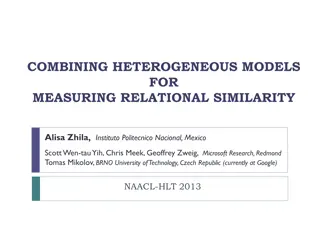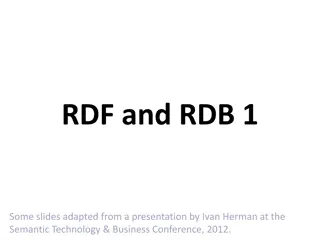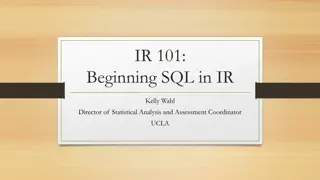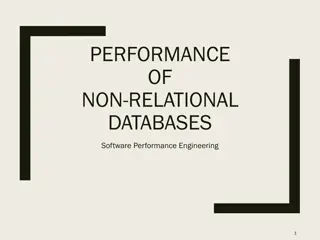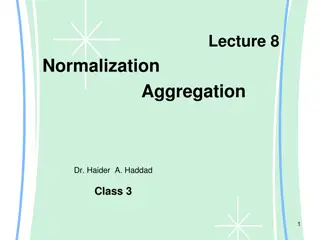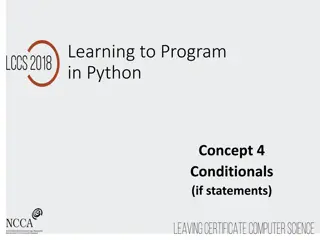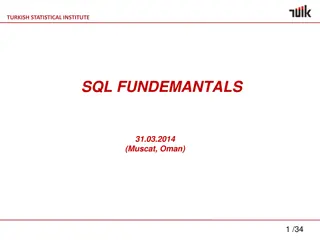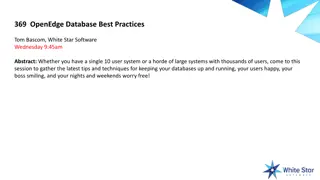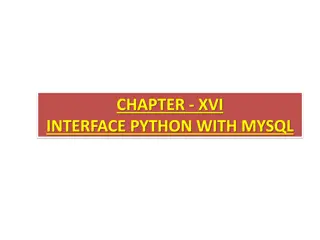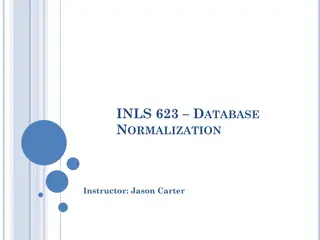Understanding the Key Concepts of Relational Databases
Introduction to the fundamental concepts of relational databases including the relational model proposed by Edgar F. Codd, relation schemes, relation instances, keys for a relation, and more. Discover the significance of keys, candidate keys, superkeys, and primary keys in database design.
Download Presentation

Please find below an Image/Link to download the presentation.
The content on the website is provided AS IS for your information and personal use only. It may not be sold, licensed, or shared on other websites without obtaining consent from the author. Download presentation by click this link. If you encounter any issues during the download, it is possible that the publisher has removed the file from their server.
E N D
Presentation Transcript
Relational Model Ali Akbar Mohammadi
Introduction Introduction Proposed by Edgar. F. Codd (1923-2003) in the early seventies. [ Turing Award 1981 ] Most of the modern DBMS are relational. Simple and elegant model with a mathematical basis. Led to the development of a theory of data dependencies and database design. Relational algebra operations crucial role in query optimization and execution. Laid the foundation for the development of Tuple relational calculus and then Database standard SQL Ali Akbar Mohammadi 2
Relation Scheme Relation Scheme Consists of relation name, and a set of attributes or field names or column names. Each attribute has an associated domain. Example: Ali Akbar Mohammadi 3
Relation Instance Relation Instance A finite set of tuples constitute a relation instance. A tuple of relation with scheme R = (A1, A2, , Am) is an ordered sequence of values(v1,v2, ... ,vm ) such that vi domain (Ai), 1 i m Ali Akbar Mohammadi 4
Another Relation Example Another Relation Example enrollment (studentName, rollNo, courseNo, sectionNo) Ali Akbar Mohammadi 5
Keys for a Relation Keys for a Relation Key: A set of attributes K, whose values uniquely identify a tuple in any instance. And none of the proper subsets of K has this property. Example: {rollNumber} is a key for student relation.{rollNumber, name} values can uniquely identify a tuple but the set is not minimal not a Key A key can not be determined from any particular instance data it is an intrinsic property of a scheme it can only be determined from the meaning of attributes Ali Akbar Mohammadi 6
Continue Continue A relation can have more than one key. Each of the keys is called a candidatekey Example: book (isbnNo, authorName, title, publisher, year) (Assumption : books have only one author ) Keys: {isbnNo}, {authorName, title} A relation has at least one key -the set of all attributes, in case no proper subset is a key. Superkey: A set of attributes that contains any key as a subset. A key can also be defined as a minimal superkey. Primary Key: One of the candidate keys chosen for indexing purposes ( More details later ) Ali Akbar Mohammadi 7
Relational Database Scheme and Instance Relational Database Scheme and Instance Relational database scheme: D consist of a finite no. of relation schemes and a set I of integrity constraints. Integrity constraints: Necessary conditions to be satisfied by the data values in the relational instances so that the set of data values constitute a meaningful database Domain constraints Key constraints Referential integrity constraints Database instance: Collection of relational instances satisfying the integrity constraints. Ali Akbar Mohammadi 8
Domain and Key Constraints Domain and Key Constraints Domain Constraints: Attributes have associated domains - Domain: set of atomic data values of a specific type. - Constraint: stipulates that the actual values of an attribute in any tuple must belong to the declared domain. Key Constraint: Relation scheme associated keys - Constraint: if K is supposed to be a key for scheme R, any relation instance r on R should not have two tuples that have identical values for attributes in K. - Also, none of the key attributes can have null value. Ali Akbar Mohammadi 9
Foreign Keys Foreign Keys Tuples in one relation, say r1(R1), often need to refer to tuples in another relation, say r2(R2) To capture relationships between entities. Primary Key of R2: K= {B1, B2, , Bj} A set of attributes F= {A1, A2, , Aj} of R1 such that dom(Ai) = dom(Bi), 1 i j and whose values are used to refer to tuples in r2 is called a foreign key in R1referring to R2. R1, R2can be the same scheme also. There can be more than one foreign key in a relation scheme. Ali Akbar Mohammadi 10
Foreign Key Foreign Key Examples(1/2) Examples(1/2) Foreign key attribute deptNo of course relation refers to Primary key attribute deptID of department relation Ali Akbar Mohammadi 11
Foreign Key Foreign Key Examples(2/2) Examples(2/2) It is possible for a foreign key in a relation to refer to An Example: univEmployee ( empNo, name, sex, salary, dept, reportsTo) reportsTois a foreign key referring to empNo of the same relation. Every employee in the university reports to some other employee for administrative purposes -except the vice-chancellor, of course! the primary key of the relation itself. Ali Akbar Mohammadi 12
Referential Integrity Constraint (RIC) Referential Integrity Constraint (RIC) Let F be a foreign key in scheme R1 referring to scheme R2 and let K be the primary key of R2. RIC: any relational instance r1 on R1, r2 on R2 must be s.t for any tuple t in r1, either its F-attribute values are null or they are identical to the K-attribute values of some tuple in r2. RIC ensures that references to tuples in r2 are for currently existing tuples. That is, there are no dangling references. Ali Akbar Mohammadi 13
(RIC) (RIC) - -Example Example Ali Akbar Mohammadi 14
Example Relational Scheme Example Relational Scheme student (rollNo, name, degree, year, sex, deptNo, advisor) Here, degree is the program ( B Tech, M Tech, M S, PhD etc) for which the student has joined. Year is the year of admission and advisor is the EmpId of a faculty member identified as the student s advisor. department (deptId, name, hod, phone) Here, phone is that of the department s office. professor (empId, name, sex, startYear, deptNo, phone) Here, startYear is the year when the faculty member has joined the department deptNo. Ali Akbar Mohammadi 15
Example Relational Scheme Example Relational Scheme course (courseId, cname, credits, deptNo) Here, deptNo indicates the department that offers the course. enrollment (rollNo, courseId, sem, year, grade) Here, sem can be either odd or even indicating the two semesters of an academic year. The value of grade will be null for the current semester and non-null for past semesters. teaching (empId, courseId, sem, year, classRoom) prerequisite (preReqCourse, courseID) Here, if (c1, c2) is a tuple, it indicates that c1 should be successfully completed before enrolling for c2. Ali Akbar Mohammadi 16
Example Relational Scheme Example Relational Scheme student (rollNo, name, degree, year, sex, deptNo, advisor) department (deptId, name, hod, phone) professor (empId, name, sex, startYear, deptNo, phone) course (courseId, cname, credits, deptNo) enrollment (rollNo, courseId, sem, year, grade) teaching (empId, courseId, sem, year, classRoom) preRequisite(preReqCourse, courseID) Ali Akbar Mohammadi 17
Example Relational Scheme with RICs shown Example Relational Scheme with RIC s shown Ali Akbar Mohammadi 18
Relational Algebra Relational Algebra A set of operators (unary and binary) that take relation instances as arguments and return new relations. Gives a procedural method of specifying a retrieval query. Forms the core component of a relational query engine. SQL queries are internally translated into RA expressions. Provides a framework for query optimization. RA operations: select( ), project( ), cross product( ),union( ), intersection( ), difference( ), join ( ). Ali Akbar Mohammadi 19
The The select select Operator Operator Unary operator. can be used to select those tuples of a relation that satisfy a given condition. Notation: ( r) : select operator ( read as sigma) : selection condition r: relation name Result: a relation with the same schema as r consisting of the tuples in r that satisfy condition Select operation is commutative: c1 ( c2( r)) = c2 ( c1( r)) Ali Akbar Mohammadi 20
Selection Condition Selection Condition Select condition: Basic condition or Composite condition Basic condition: Either Ai <compOp> Aj or Ai <compOp> c Composite condition: Basic conditions combined with logical operators AND, OR and NOT appropriately. Notation: <compOp> : one of < , , > , , = , Ai, Aj : attributes in the scheme R of r c : constant of appropriate data type Ali Akbar Mohammadi 21
Examples of Examples of select select expressions expressions 1.Obtain information about a professor with name Ali name= Ali (professor) 2.Obtain information about professors who joined the university between 2010 and 2013 startYear 2010 ^ startYear < 2013(professor) Ali Akbar Mohammadi 22
The The project project Operator Operator Unary operator. Can be used to keep only the required attributes of a relation instance and throw away others. Notation: A1,A2, ,Ak(r ) where A1,A2, ,Akis a list L of desired attributes in the scheme of r. Result = { (v1,v2, ,vk) | vi dom(Ai) , 1 i k and there is some tuple t in r s.t t.A1 = v1, t.A2 = v2, , t.Ak = vk} If r1= L(r2) then scheme of r1 is L Ali Akbar Mohammadi 23
Examples of Examples of project project expressions expressions Ali Akbar Mohammadi 24
Size of Size of project project expression result expression result If r1= L(r2) then scheme of r1 is L What about the number of tuples in r1? Two cases arise: Projection List L contains some key of r2 Then |r1| =|r2| Projection List L does not contain any key of r2 Then |r1| |r2| Ali Akbar Mohammadi 25
Set Operators on Relations Set Operators on Relations As relations are sets of tuples, set operations are applicable to them; but not in all cases. Union Compatibility: Consider two schemes R1, R2 where R1= (A1, A2, , Ak); R2= (B1, B2, , Bm) R1 and R2 are called union-compatible if k = m and dom(Ai)= dom(Bi)for 1 i k Set operations union, intersection, difference Applicable to two relations if their schemes are union-compatible If r3= r1 r2, scheme of r3 is R1 (as a convention) Ali Akbar Mohammadi 26
Set Operations Set Operations r1-relation with scheme R1 r2-relation with scheme R2-union compatible with R1 r1 r2= {t | t r1 or t r2}; r1 r2= {t | t r1 and t r2}; r1 r2= {t | t r1 and t r2}; By convention, in all the cases, the scheme of the result is that of the first operand i.e. r1. Ali Akbar Mohammadi 27


